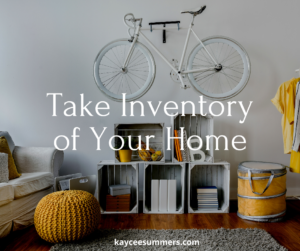How to Protect Your Home (and Not Break Your Budget) Series
My 4-week series is a must for every homeowner. Once you buy a home, it’s now all your responsibility! But are you truly prepared for the unexpected? This series is a great overview on what you need to know when it comes to getting homeowner’s insurance, keeping your home safe and secure, and avoiding costly mistakes when protecting your home.

This week you’ll learn why keeping an itemized list of your home’s contents is a HUGE help when you need to make an insurance claim.
No one wants their home damaged or destroyed by fire or flooding. Or have treasured items stolen from them. It’s devastating to even think about it.
That’s why you – like all homeowners — rely on insurance coverage to help cover the cost to rebuild your home and replace your belongings. Having it gives you some comfort and relief, right?
But even good insurance is only as good as the records YOU keep!
Your insurance company can only be as helpful to you as you are to them. It’s a simple fact, and that’s why you need to take inventory of your belongings.
Why It Matters
Take a look around your home and most likely it’s filled with many different items, some worth more than others, some more precious to you, and some just part of your day-to-day life.
But if you add them all up, the value of your belongings could be quite high. Are you covered for that? What happens when you need to make a claim and prove the value?
Taking an inventory of all of you items throughout your home:
- It gives you a better idea of how much coverage you actually need, and
- It can help verify the value of your belongings when you file a claim, and even facilitate the process.
Your inventory can help the claims process tremendously since there is no second guessing since you can provide both visual and documented proof.
Getting It Right … and Making It Easy
A home inventory is exactly as it sounds. Pulling together a detailed list of items in your home … furniture, fixtures, paintings, jewelry, appliances, electronics, etc. And with that making sure you take a picture and include a description, serial number, model, purchase date, and estimated value (include any receipts) for each item.
Taking pictures and making a detailed list sounds difficult and overwhelming, doesn’t it? And on top of that, where do you keep these records so that they aren’t also destroyed if your home is?
It actually can be quite simple with one of the online options out there.
You can download an online software program, either on your own or through your insurance company, that is specifically designed to help you itemized all of your stuff!
These inexpensive online programs can guide you through the process and make taking inventory of your home much easier and more organized.
Nest Egg
Available on: iOS
Cost: Free (subscription available for more features)
The Nest Egg app takes home inventory technology to the next level. Their paid version of the app allows users to scan barcodes of their items and will automatically find and save product information for you to access at any time. It also has a notepad and reminder function to help you remember to return borrowed items or pay your insurance premiums on time. Not interested in paying $3.99 a month (or $7.99 a month for their enhanced platform)? No problem. Nest Egg’s free version operates similarly, though it’s important to note that it doesn’t back up your information to the cloud-like its paid counterparts.
If this type of software doesn’t work for you, you can always take the time to save your photos and lists on a safe online system like Dropbox or iCloud that can be accessed anywhere. Some people even like to take a video of their home and walk from room to room to document their stuff. Again, easy to save online.
No matter what system you choose, the most important thing is that you’re organized and prepared if something happens to your home.
Keep It Safe
Never store your inventory list at home where it can be damaged. That’s why online programs are a great way to keep your itemized lists and pictures safe and accessible when there is an emergency. Digital records can be stored in Dropbox or iCloud. If you still need a paper back-up, save those documents in a safe deposit box or secured place outside of your home.
Next week is the last installment of my How to Protect Your Home (And Not Break Your Budget) Series. You’ll learn why it’s important to budget now so you’re ready for any costly maintenance blunders. Plus how to avoid those homeowner mistakes!
Hi, there!
I'm Kaycee and I love helping first time home buyers make their first home more affordable and I love helping sellers looking to move up to their forever home. Let me know how I can help you make your real estate dreams come true.
Let's Meet
Contact
775-720-7320
1470 US Hwy 395
Gardnerville, NV 89410
info@kayceesummers.com
Buy
My Listings
Sell
All Articles
schedule your free consultation